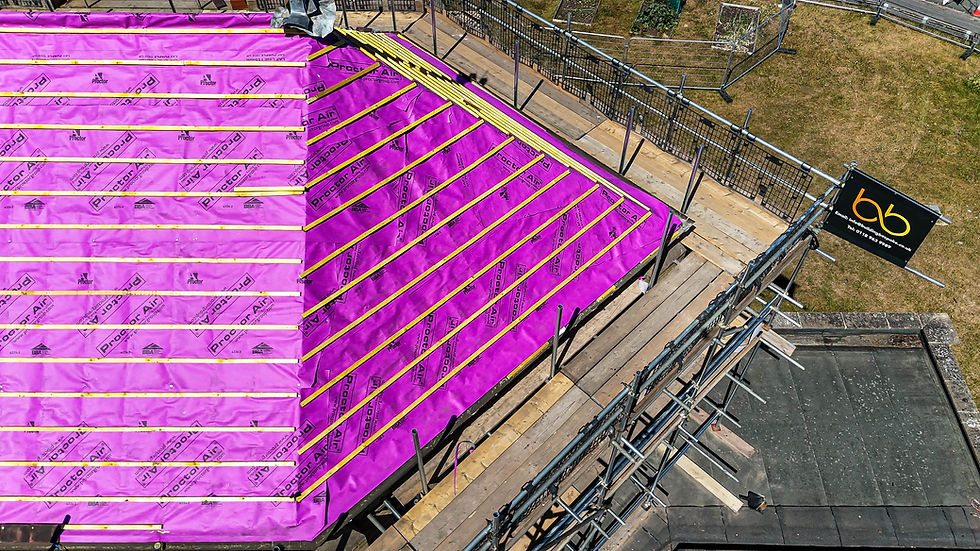Why fire-rated membranes are vital for multi-occupancy buildings
- Specify & Build
- 4 days ago
- 3 min read
Often referred to as ‘hidden protectors’, fire-rated construction wall membranes can help play a key role in reducing façade fire risk. James Smith, Head of Technical from Glidevale Protect, takes a closer look at what specifiers should consider.
From high-rise residential developments to low-rise housing schemes, housing market requirements are vast, varied and vital to address through the specification of compliant building products. External wall breather membranes are a well-established part of façade design within residential high rise buildings. Internal air and vapour control layers (AVCLs) help ensure airtightness, control condensation risk and with reflective products, can improve overall thermal performance.

In high-rise residential developments, external wall breather membranes must provide moisture control and also perform in terms of reaction to fire. With wall systems often made up of multiple components sourced from different suppliers, it’s important to demand empirical evidence that the membranes have been individually fire tested both as part of a system application and on its own without a substrate. Increasingly, the industry is recognising the value of using fully tested fire rated wall membrane and tape system from a sole supplier, where the product’s reaction to fire classification is achieved both in a free-hanging condition and fixed over A1 and A2 substrates.
Testing times
The minimum requirement for external wall membranes in residential buildings above 11m is a Class B-s3, d0 rating to BS EN 13501-1. This is currently classified as an exemption in Building Regulations Approved Document Part B, but there are benefits of ‘future-proofing’ by specifying membranes that exceed the regulations, such as the Class A compliant products offered by Glidevale Protect. In addition, regional variations of the minimum requirement do apply. For example, in Greater London, non-combustible or limited combustibility materials (Class A1 or A2-s1, d0) are mandated for buildings under Greater London Authority control. Class B membranes are classified as combustible materials with very limited contribution to fire, whereas A2 membranes have limited combustibility and very limited contribution to fire.
Achieving a Class A2 reaction to fire classification means passing both the ISO 1716 heat of combustion test and the BS EN 13823 Single Burning Item (SBI) test, but any product classification can be misleading if presented out of context. For example, fire test data may only relate to the membrane being fixed to an A1 or A2 substrate rather than also achieving the same reaction to fire classification in a free-hanging condition. It’s crucial to ensure that an FR membrane is not solely dependent on the substrate to achieve the product’s quoted fire performance as this can reduce the fire classification of the overall system. Instead, it’s vital to understand the true fire performance of the individual membranes used and how each of these components fare when the material is fire tested.

Specifiers should check whether membranes have been tested in relevant scenarios: as part of a system with different substrates, with appropriate fixings and with fire rated tapes included. This is essential to satisfy the ‘golden thread’ requirements and ensure there is an evidence trail, which is important for high risk buildings as detailed in the Building Safety Act.
A holistic solution
While external wall membranes receive more focus in fire strategies, internal air and vapour control layers can also contribute to fire resilience. Specifying a Class A2 fire-rated AVCL that has been independently fire tested both free hanging and with a substrate, in conjunction with an external fire rated breather wall membrane, will help provide a cohesive fire-rated membrane system that can help minimise fire spread and offer added fire protection.
Membranes are a vital part of the building envelope and, in the residential market, where risk is amplified and regulatory expectations are tightening, this level of detail and scrutiny really matters. Fire-rated membranes, both internal and external, should be specified not as individual products, but as part of a membrane wall system. It’s a small but important step in mitigating fire risk and safeguarding a building’s performance in the long term.
.png)























































.png)

